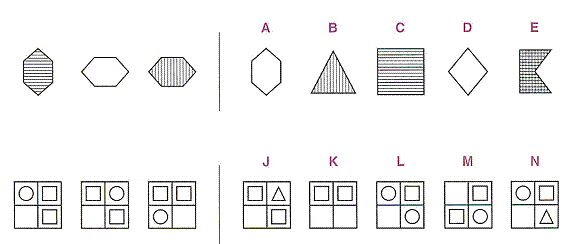-
Verbal Battery- verbal classification, sentence completion, verbal analogies.
-
Quantitative Battery - quantitative relations, number series, equation building.
-
Non-Verbal Battery - figure classification, figure analogies, figure analysis.
Cognitive Abilities Test (CogAT) Verbal Subtests
The Verbal Battery tests a student's vocabulary, as well as his/her comprehension of ideas, efficiency and verbal memory, and ability to discover word relationships. Statistics show a high correlation between high verbal ability and success in a variety of school subjects.
Three sub-tests are administered in the verbal section. Each sub-test has about 20 questions and the student is given 10 minutes to complete each sub-test. These three sub-tests comprise the verbal score.
Verbal Classification: The student is given a list of three words that are alike in some way. The student is asked to choose a word, from a selection of five words, that is also alike in the same way.
|
Example: |
Green Blue Red |
|
Choices: |
color; crayon; paint; yellow; rainbow |
Sentence Completion: The student is given a sentence with a word left out and is asked to choose a word that makes the best sense in the sentence.
|
Example: |
Apples _______ on trees. |
|
Choices: |
fall; grow; show; bloom; spread |
Verbal Analogies: The student is given three words in dark type. The first two words go together. The third word goes with one of the answer choices. The student is asked to choose the word that goes with the third word the same way that the second word goes with the first.
|
Example: |
new (is to) old : wet (is to) |
|
Choices: |
rain; drip; hot; sun; dry |
Cognitive Abilities Test (CogAT) Quantitative Subtests
The Quantitative Battery tests the student's quantitative reasoning and problem solving ability and provides an appraisal of the student's general level of abstract reasoning
Three sub-tests are administered in the quantitative battery. The first test has twenty-five questions and students are given 8 minutes to finish. The second has 20 questions with a 10 minute testing time. The third has fifteen questions with a 12 minute testing time.
Quantitative Relations: The student is given two problems numbered one and two with three answer choices. The student is to solve the two problems and determine if the answer is greater, less than, or equal to.
|
Example: |
1. 0 + 3
2. 3+0 |
|
Choices: |
a) 1 is greater than 2; b) 1 is less than 2; c) 1 is equal to 2 |
Number Series: The student is given a series of numbers and is asked to decide which number should come next in the series.
|
Example: |
5 10 15 20 |
|
Choices: |
25; 30; 35; 40; 45 |
Equation Building: The student is given numbers and signs. The student is asked to combine the numbers and signs to get a solution that is an answer choice.
|
Example: |
1 2 3 - x |
|
Choices: |
1; 2; 3; 4; 6 |
Cognitive Abilities Test (CogAT) Nonverbal Subtests
The Nonverbal Battery present the most novel problems to students. The items on these tests use only geometric shapes and figures that have had little direct relationship to formal school instruction. The tests require no reading. It is argued that the nonverbal battery is particularly suitable for obtaining an accurate estimate of development for students who have difficulty with reading; who have limited competency in English; or who have limited opportunities. The tests in the nonverbal battery are between fifteen and twenty-five questions each and students are given ten minutes for each test. (For examples of how these might be presented on the test see the Figural section of the relevant level of Building Thinking Skills.)
Figure Classification: The student is given three figures that are alike in some way. They are asked to decide which of five options goes best with the three figures.

Figure Analogies: The student is given three figures. The first two figures go together in some way; the third figure goes with one of the answer choices in the same way.

Figure Analysis: The student is shown how a square piece of dark paper is folded and where holes are punched in it. The student is to figure out how the paper will look when it is unfolded.
